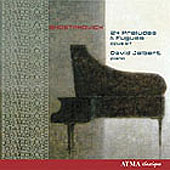
ESSENTIAL RECORDINGS

During his youth, Shostakovich's primary instrument was the piano, so much so that he was set on a career as a performer, but eventually, composing took over. However, he remained faithful to the piano all his life, and his admiration for the music of Bach was such that he would play at least one piece of the German master every day. In 1950, Shostakovich was invited to be a judge at a prestigious piano competition commemorating the 200th anniversary of Bach's death. He was so impressed by Tatiana Nikolayeva's performance of Bach's Well-Tempered Clavier, that he eventually decided to compose his own complete set of Preludes & Fugues for Nikolayeva. That is how this intimate piano work came about,
from a composer of massive symphonies, controversial operas and profound chamber music.
They were composed over a period of about six months, à la Bach, as pure, academic and formulaic music. Still, Shostakovich being who he was, darkness, desolation, irony, human emotions, spiky circus-like comical music, all of these aspects slowly crept in and became the music.
For example, the Prelude No. 1 in C major, sounds like a baroque sarabande, but after a few well placed dissonances, comes down with a case of 20th century angst. The Fugue No. 8 in F sharp minor has an atmosphere of desolation. No. 12 in G sharp minor is totally intellectual in it's harmonic fugual treatment, while some 5-part fugues are very deep and sombre. This definitely requires more attentive listening than the Bach set, but is ultimately more rewarding.
You can tell that in this February 2008 release, David Jalbert approaches the music with awe and respect. He displays a lightness of touch combined with a deep musical imagination. He can switch from a pensive and sombre prelude to a spiky fugue with the least effort, and presents some new insights into the music. The best example is those repetitive, stammering notes in the Fugue No. 5 in D major. Notice how he makes each one sound like an echo of the previous note. The recorded sound is very good, with some air and distance between you and the piano, as if the instrument is on a small stage rather than in your living room.
Music that lingers in the mind long after it's been heard.
Jean-Yves Duperron